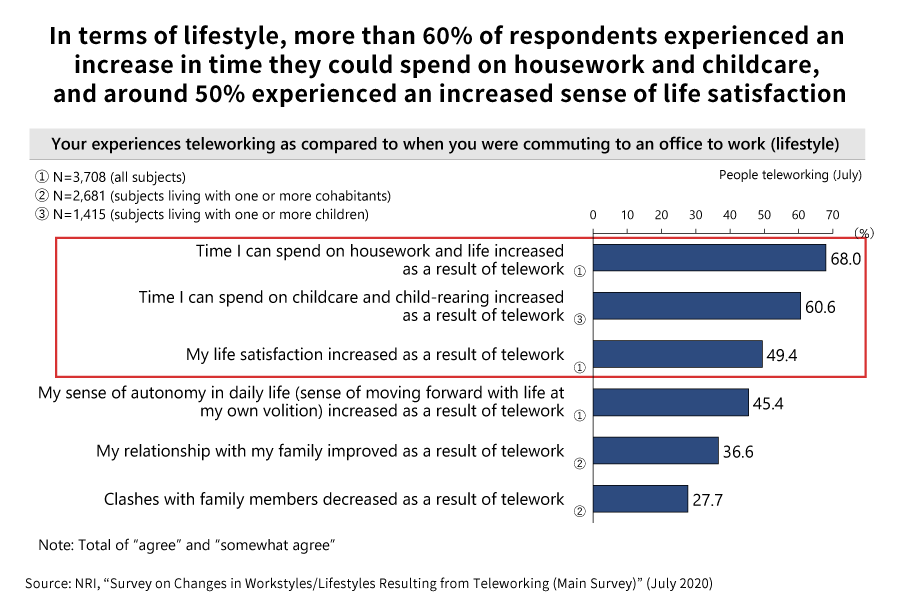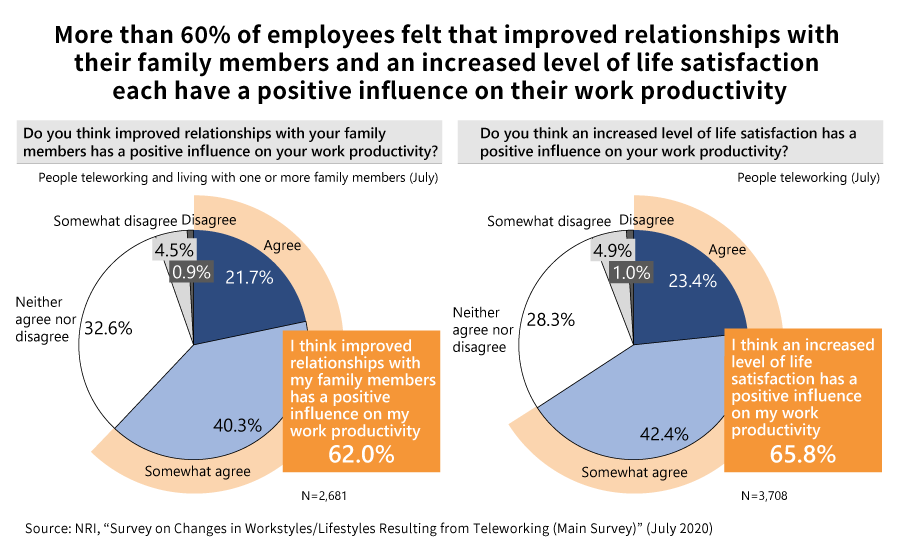
Towards Workstyle Reforms in Japan and Female Workforce Engagement After Covid-19
Since the start of the spread of Covid-19, Nomura Research Institute (NRI) has carried out multiple surveys to uncover changes in workstyle and the workforce (“Survey on Telework etc. During the Spread of Covid-19 (May 2020)” and “Survey on the Spread of Covid-19 and Workstyles/Lifestyles (July 2020)”). We asked Kana Takeda of the Center for Strategic Management & Innovation, who was involved in the surveys and analysis, about how companies should understand the rapid increase in “telework” and the possibility that a new workstyle involving remote working (including telework) taking root could promote women’s engagement in the workforce.
Rapid development of remote work environments caused improved assessment of productivity
The surveys revealed that during Japan’s national State of Emergency around 70% of employees, and as of the end of July around 50% of employees, were teleworking, and that around 70% of those who had worked from home during the State of Emergency were still teleworking at the end of July.
Generally, reduced productivity is cited as a problem with telework. Even Professor Nicholas Bloom (Stanford University), known for his research showing that employees’ productivity improved when teleworking, has said that it will be difficult to expect high productivity as in normal times when employees are teleworking during the Covid-19 pandemic. Bloom explains that this is because people teleworking during the Covid-19 pandemic are working while caring for their children, because it is difficult to ensure an appropriate work environment, because it is difficult to ensure privacy, and because these workers have no choice in their workstyle. The aforementioned NRI survey also showed that as of May, more than 60% of employees were working while caring for children, and 50% were working in a space they shared with their family. It is considered highly likely that the factors indicated by Bloom caused a reduction in productivity due to telework in Japan as well.
The survey carried out at the end of July, however, showed that while overall those who felt telework had caused a reduction in their productivity was rather high in the range of 40% to 50%, the percentage of those who felt that their productivity had increased was 10% higher than at the end of May. We surmise that the reason for respondents’ assessment of their productivity improvement is that at the end of July, schools, daycares, and the like had reopened, leading to significant resolution of the problem of working while caring for children, and also that companies had engaged in rapid development of remote work environments including revisions of their actual IT environments and work operations, with their workforces attaining proficiency within those environments.
Possibility of telework use contributing to improved wellbeing and productivity
Nearly half of respondents felt that their sense of autonomy increased in terms of work as a result of telework, and more than 30% felt an increase in their desire to continue working at their current company. These trends were seen more prevalently in women than in men, and more in those in their 20s and 30s than those in their 40s and 50s.
Further, more than 60% of respondents experienced an increase in time they could spend on housework and childcare, and around 50% experienced an increased sense of life satisfaction. These trends were also seen more prevalently in women than in men, and more in those in their 20s and 30s than those in their 40s and 50s.

Additionally, more than 60% of workers felt that improved relationships with their family members had a positive influence on their work productivity, and more than 60% of workers felt that an increased level of life satisfaction had a positive influence on their work productivity. Both trends were prevalent among women.

These survey results suggest that with telework getting implemented in the wake of the Covid-19 pandemic and becoming a prolonged arrangement, we are seeing the possibility of telework leading to improved productivity. Companies should pay attention to this revelation; the test for companies going forward will be whether they learn the views of the workforce that were brought to light through these surveys and recreate environments where each worker can maximally exhibit his or her skill in his or her work.
One in two female regular employees are “integrated-career” women * that are eager for achievements in both life and career
Working women have until now been assumed to be either “career-oriented”, avoiding letting household and personal commitments limit their work as much as possible and placing emphasis on work achievements and career advancement, or “life-oriented”, prioritizing ensuring time for household commitments and private life and preferring to work only to the extent that these other commitments allow. However, in reality, there are “integrated-career” women who want to put forth effort both into home and childcare and into their work and careers. According to a survey that NRI performed in 2018, one in two women working as a regular employee is an “integrated-career” woman (“Survey Asking 5,454 Working Women Their True Thoughts on Work and Career”).
What management needs to do to maximally draw out the full potential of these “integrated-career” women can be summarized by the following three elements: “expectations”, “sharing”, and “providing opportunities”.
“Expectations” refers to expecting these women to grow and contribute on the job. Management should avoid postponing or hesitating to have high expectations for women for the reason that their children are still young or they only just returned to work after maternity leave, and should instead expect that such “integrated-career” women will grow steadily through their work and show results that contribute to the organization, and should further tell these women of these expectations so that they are aware of them.
“Sharing” refers to women sharing their eagerness to work and the home situations surrounding them so that management confirms with the individual and gains a concrete understanding of “her true eagerness to work and have a career” and the “home situation surrounding the worker herself” instead of assuming her will and her situation based on her workstyle.
Finally, “providing opportunities” means first providing opportunities in order to quickly create an environment where the employee can produce results, rather than providing opportunities only after an environment in which she can produce results has been arranged.
-
*
“Integrated-career women” is a name for members of the workforce having the new values and behavioral characteristics announced by NRI in July 2015.
The real reason establishment of a new workstyle utilizing remote work will promote female workforce engagement
The three elements listed above can also be thought of as tips for management while employees are working remotely. That is because around 60% of managers really feel that “it is necessary to more fully ascertain the eagerness and thoughts toward work” of their subordinates who telework, and half of managers believe that “it is necessary to more fully ascertain [employees] home situations”.
Further, in a survey of men working in managerial positions carried out by NRI in July 2020, 60% of managers responded that as a result of use of telework and other forms of remote work becoming the norm, compared to in the past, “it is easier to have high expectations of” and “it is easier to consider hiring” female subordinates who work while caring for children (“Survey on Human Resource Management After Covid-19 (Survey of Male Managers)”). Moreover, over 80% of managers responded that telework is an effective way to employ the talents of female subordinates who work while caring for children and to grow their organization.
The investigation into and implementation of the “new management” needed in an environment where employees work isolated from one another is arguably a chance to promote the “three elements” that hold the key to making the most of “integrated career” women, and to make even greater advancements in promoting female workforce engagement after Covid-19. Not only the new workstyle utilizing remote work, but the very “changes in management” that will occur as a result of the implementation and establishment of this new workstyle will also serve as a driving force to greatly advance female workforce engagement after Covid-19.
Profile
-
Kana Takeda
* Organization names and job titles may differ from the current version.